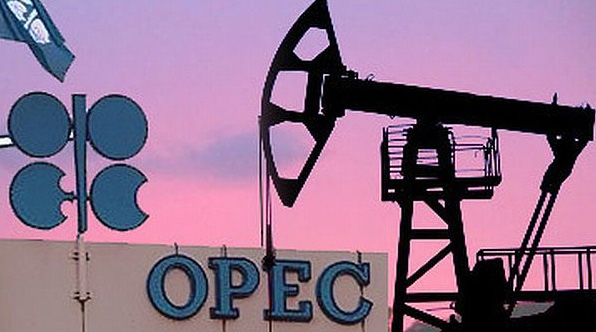Azerbaijan's gas exports jump

By Fatma Babayeva
Azerbaijan’s gas exports increased by 0.9 percent to 8.1 billion cubic meters in 2015 compared to year a before, reported OPEC in its annual statistical bulletin released on June 22.
The proven gas reserves of the country are estimated by the organization to amount to 1.2 trillion cubic meters. Its gas production was 19.3 billion cubic meters in 2015, which is 3.9 percent increase compared to 2014.
In the meantime, Azerbaijan’s crude oil production fell by 0.8 percent to 786,700 barrels a day in 2015 compared to 2014, according to the bulletin.
Its proven crude oil reserves amounts to 7 billion barrels, and the number of its active oil rigs is 17, reads the report.
Azerbaijan’s refinery capacity in 2015 was 399,000 barrels a day, whilst its refinery throughput plunged by 4.4 percent to 125,900 barrels a day compared to year before. Azerbaijan’s petroleum products also experienced a decrease by 2.5 percent in 2015 – 125,300 barrels a day.
Global data
OPEC highlighted in its report that global oil demand averaged 93.0 million barrels a day in 2015, which is 1.7 percent more compared to year before, with the largest increases taking place in Asia Pacific, particularly India and China, North America, Western Europe, the Middle East and Africa.
Total OECD oil demand grew soundly during 2015 (by 1 percent to 46.18 million barrels), while it declined in Latin America for the first time since 2003, stated the bulletin.
In the meantime, OPEC oil demand remained robust during 2015 in the Middle East, Africa and Asia Pacific.
Distillates and gasoline account for around 56 percent of total world oil demand and were on increasing trends, while residual fuel oil requirements declined for another year, read the bulletin, adding that gasoline dominated 2015 oil demand growth in Asia Pacific and North America, while distillates appeared robust in Western and Eastern Europe.
In 2015, world crude oil production increased by 1.75 million barrels a day, or 2.4 percent compared to 2014, stated the report by stressing that the U.S. had the biggest yearly increase in this regard among non-OPEC countries (by 0.72 million barrels a day or 8.3 percent).
Meanwhile, OPEC’s crude oil production averaged 32.32 million barrels a day during 2015, increasing by 0.93 million barrels a day or 3.0 percent, over 2014, the first surge in production after two years of decline. The organization’s crude oil exports stood at 23.6 million barrels a day in 2015, up slightly from 23.2m b/d in 2014.
In 2015, the top three crude oil producing countries were Saudi Arabia (10.19 million barrels a day), Russia (10.11 million barrels a day) and the United States (9.43 million barrels a day). Saudi Arabia displaced Russia from first place for the first time since 2005.
North America imported 2.8 million barrels a day of crude oil from OPEC’s member countries, which is 10.6 percent less than during 2014. Additionally, the U.S. was the largest consumer of oil, according to the cartel. Its oil demand in 2015 amounted to 19.4 million barrels a day, which is 2.5 percent decrease since 2014.
The OPEC’s bulletin highlights that total world proven crude oil reserves stood at 1,493 billion barrels in 2015, increasing slightly by 0.1 percent from the previous year’s level of 1,490 billion barrels. The largest additions came from Angola, Venezuela and IR Iran, while declines were seen in Norway, the UK and Colombia.
In the meantime, world refinery capacity expanded by 0.8 million barrels crude per day to stand at 96.6 barrels crude per day during 2015, mainly supported by additions in the Middle East and Asia Pacific regions. In the Middle East, expansions came largely from OPEC member states, while in the Asia Pacific region growth came predominantly from India and China. Refinery capacity in the OECD region continued to decline despite small gains seen in the United States.
Regarding the global gas demand, OPEC estimated an increase by 1.9 percent to 3.49 trillion cubic meters, while OECD countries’ demand for gas stood at 1.63 trillion cubic meters, which is 1.6 percent more compared to the figures in 2014.
The U.S. was the biggest consumer and producer of natural gas as well, according to the bulletin. Its gas demand equaled to 777.95 billion cubic meters, which is 2.9 percent increase compared to 2014, whist the amount of the traded gas that is produced totaled 768.83 billion cubic meters, which is 5.3 percent increase compared to year before.
Second largest producer of gas was Russia with 637.39 billion cubic meters (0.9 percent less compared to 2014). Russia is followed by Iran (226.67 billion cubic meters) and Qatar (178.47 billion cubic meters) in the list.
Nevertheless, Russia accounts for the largest holder of the world’s total gas reserves (49.54 trillion cubic meters). The list continues with Iran (33.5 trillion cubic meters), Qatar (24,299 trillion cubic meters) and the U.S. (11.01 trillion cubic meters – same with the figure in 2014).
Overall, OPEC lowered its estimates for the global proven gas reserves by 0.3 percent to 201.967 trillion cubic meters in 2015.
---
Fatma Babayeva is AzerNews’ staff journalist, follow her on Twitter: @Fatma_Babayeva
Follow us on Twitter @AzerNewsAz
Here we are to serve you with news right now. It does not cost much, but worth your attention.
Choose to support open, independent, quality journalism and subscribe on a monthly basis.
By subscribing to our online newspaper, you can have full digital access to all news, analysis, and much more.
You can also follow AzerNEWS on Twitter @AzerNewsAz or Facebook @AzerNewsNewspaper
Thank you!
